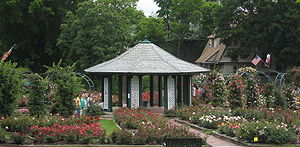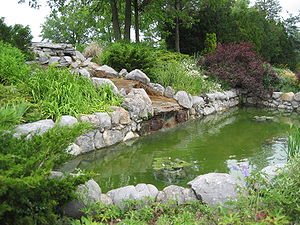
Thornden Park
Encyclopedia
Thornden Park is a 76 acres (30.8 ha) park in Syracuse, New York
, which is the second largest in the city after Burnet Park
. It was purchased by the city in 1921 and has become a favorite wedding location in the Syracuse park system. It is located in Westcott
, and borders the University Neighborhood and University Hill
neighborhoods. The park was listed on the National Register of Historic Places
in 1994 as part of the Historic Designated Landscapes of Syracuse, New York.
, which killed approximately 600 elm trees
in the park. Maple
trees were planted as replacements. The Thornden Park Association was founded in 1983 to advocate for, restore and revitalize the park.
 One of the more popular attractions in the park is the E. M. Mills Memorial Rose Garden, dedicated in 1924 on 2 acres (8,093.7 m²) at the southwest entrance to the park, across Ostrom Avenue from Syracuse University. Since 1970, the Syracuse Rose Society has maintained the garden in cooperation with the City of Syracuse Department of Parks. Currently, the garden hosts 368 different varieties of roses (3850 plants in all) that surround a central gazebo.
One of the more popular attractions in the park is the E. M. Mills Memorial Rose Garden, dedicated in 1924 on 2 acres (8,093.7 m²) at the southwest entrance to the park, across Ostrom Avenue from Syracuse University. Since 1970, the Syracuse Rose Society has maintained the garden in cooperation with the City of Syracuse Department of Parks. Currently, the garden hosts 368 different varieties of roses (3850 plants in all) that surround a central gazebo.

Syracuse, New York
Syracuse is a city in and the county seat of Onondaga County, New York, United States, the largest U.S. city with the name "Syracuse", and the fifth most populous city in the state. At the 2010 census, the city population was 145,170, and its metropolitan area had a population of 742,603...
, which is the second largest in the city after Burnet Park
Burnet Park
Burnet Park is the largest park in Syracuse, New York, USA, covering an area of . It is located on the west end of the city, in the Far Westside in a neighborhood called Tipperary Hill.-History:...
. It was purchased by the city in 1921 and has become a favorite wedding location in the Syracuse park system. It is located in Westcott
Westcott, Syracuse
Westcott is a neighborhood in Syracuse, New York. Its proximity to Syracuse University makes for a diverse community, with many of its residents being Syracuse University students, many international, and others being more lower-income to middle class permanent residents. Westcott Street is the...
, and borders the University Neighborhood and University Hill
University Hill, Syracuse
University Hill is a neighborhood in Syracuse, New York, located east and southeast of downtown, on one of the larger hills in Syracuse. It is the major educational and medical district of Syracuse, as well as an important business district, with three of the top ten employers in the Syracuse...
neighborhoods. The park was listed on the National Register of Historic Places
National Register of Historic Places
The National Register of Historic Places is the United States government's official list of districts, sites, buildings, structures, and objects deemed worthy of preservation...
in 1994 as part of the Historic Designated Landscapes of Syracuse, New York.
History
Thornden Park began as a farm owned by Zebulon Ostrom, who sold it to a wealthy salt miner James P. Haskins around 1850. In 1921 the city purchased the land as part of the nationwide City Beautiful movement and added recreational features such as the ballfields and swimming pool. During the 1960s, however, budget cuts threatened the cleanliness of the park, a threat that was countered by neighborhood initiatives. The 1970s brought the Dutch Elm DiseaseDutch elm disease
Dutch elm disease is a disease caused by a member of the sac fungi category, affecting elm trees which is spread by the elm bark beetle. Although believed to be originally native to Asia, the disease has been accidentally introduced into America and Europe, where it has devastated native...
, which killed approximately 600 elm trees
Elm
Elms are deciduous and semi-deciduous trees comprising the genus Ulmus in the plant family Ulmaceae. The dozens of species are found in temperate and tropical-montane regions of North America and Eurasia, ranging southward into Indonesia. Elms are components of many kinds of natural forests...
in the park. Maple
Maple
Acer is a genus of trees or shrubs commonly known as maple.Maples are variously classified in a family of their own, the Aceraceae, or together with the Hippocastanaceae included in the family Sapindaceae. Modern classifications, including the Angiosperm Phylogeny Group system, favour inclusion in...
trees were planted as replacements. The Thornden Park Association was founded in 1983 to advocate for, restore and revitalize the park.
Mills Rose Garden

The Amphitheatre
The Amphitheatre was built in 1933 under the Roosevelt era WPA Project (Works Project Administration). It was originally named the Sylvn Theatre. The opening day ceremony in 1933 was rained out but the subsequent opening was attended by 10,000 people. It is built to seat 6,000 people in its concentric rings and open lawn in the middle of the amphitheatre. The Syracuse Opera puts on a free show the first Sunday in August each year and, since 2003, the Syracuse Shakespeare Festival has presented its free, Shakespeare-in-the-Park program the second and third weekends of August, before the NYS Fair.Features

- Swimming pool (50 m)
- One multi-purpose field
- Five tennis courts
- Three basketball courts
- Playground
- Fitness trail
- E.M. Mills Memorial Rose Garden
- Outdoor amphitheatre
- Lily pond

